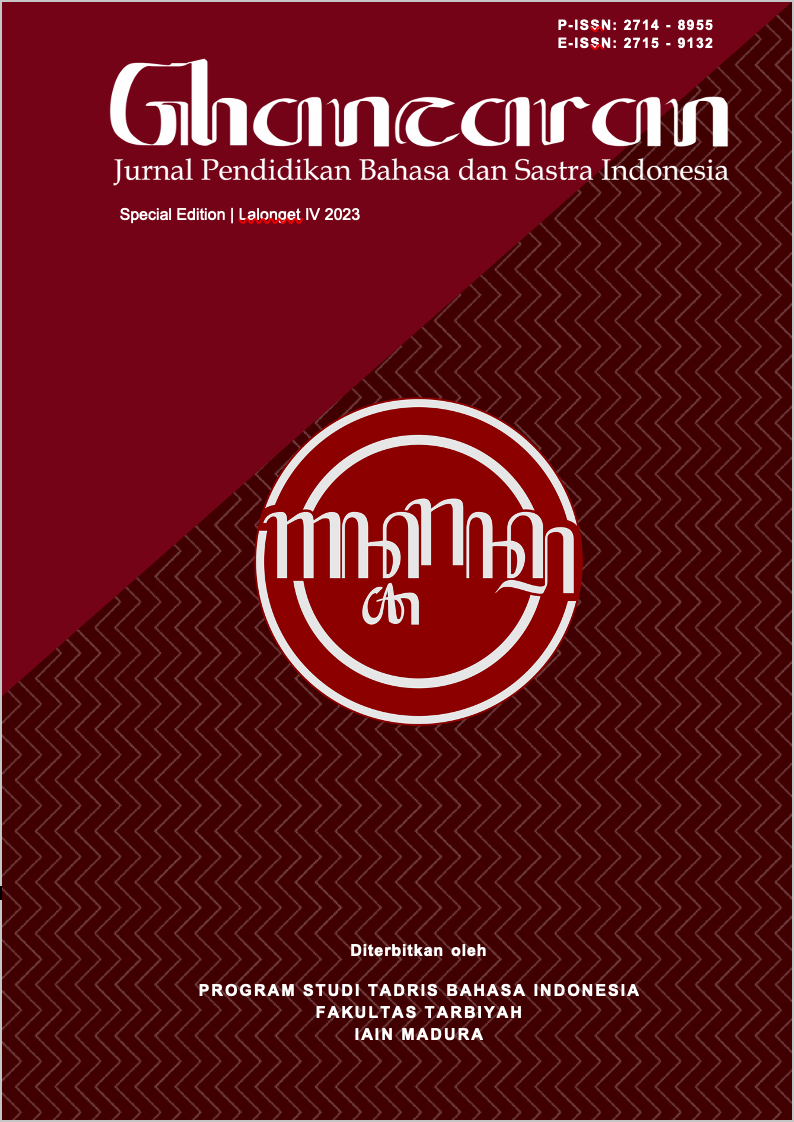Implementasi Aplikasi KBM Sebagai Media Pembelajaran Menulis Cerpen Siswa MTs Al-Amiriyyah Darussalam Banyuwangi
 Abstract views: 320
,
Abstract views: 320
,
 PDF downloads: 223
PDF downloads: 223
Abstract
The use of learning media makes it easier for teachers to convey the learning process. New and easy media can stimulate students to produce maximum learning results. This research aims to: 1) Describe the short story writing abilities of class IX students at MTs Al-Amiriiyah Darussalam Blokagung Banyuwangi. 2) Describe the process of writing short stories using the KBM application for class IX students at MTs Al-Amiriiyah Darussalam Blokagung Banyuwangi. The research method used is qualitative with a case study approach. Data collection techniques used were observation, interviews and documentation. Meanwhile, the data analysis used is the Interactive Model of Milles and Hubarman, including: data collection, data reduction, data presentation, and drawing conclusions. The validity of the data used is a triangulation. of methods, techniques and theories. The results of this research are that the abilities of class IX students at MTs Al-Amiriiyah Darussalam Blokagung Banyuwangi are very good. This can be seen from the results of the short stories written. Starting from determining intrinsic and extrinsic elements, generating problems and solving short story problems. The use of learning media makes it easier for teachers to deliver the learning process. New and easy media can stimulate students in producing maximum learning results. as well as the use of learning media to write short stories using the KBM application. This study aims to: 1) Describe the application of KBM application as a. learning medium for writing short stories for grade IX MTs Al-Amiriiyah Darussalam Blokagung Banyuwangi students. 2) Disadvantages and advantages of ascetics.
Downloads
References
Cahyawati, D., & Gunarto, M. (2021). Persepsi Mahasiswa terhadap Pembelajaran Daring pada Masa Pandemi Covid-19. Jurnal Inovasi Teknologi Pendidikan, 7(2), 150–161.
Citraningsih, D., & Wiranata, R. R. S. (2022). Analisis SWOT Pembelajaran Daring Era Pandemi Covid-19 pada Sekolah Dasar. Humanika, 22(1), 21–40.
Galingging, R. (2020). Analisis Desain Cover Buku Anak Ayo Sekolah “ Lukisan Aini”. Jurnal Magenta, 4(01), 553–563.
Hasan, J. S., & Lubis, F. (2023). Aplikasi Spotify: Solusi Baru dalam Pembelajaran Menulis Cerpen di SMA. Ghancaran: Jurnal Pendidikan Bahasa dan Sastra Indonesia, 5(1), 194–211.
Koswara, I. (2018). Revitalisasi Pembangunan Pendidikan Melalui Pendekatan Komunikasi Pendidikan. Jurnal Agregasi : Aksi Reformasi Government dalam Demokrasi, 6(1).
Lotto, L. J., & Suparman. (2016). Kemampuan Menentukan Unsur Intrinsik Cerpen Melalui Model Pembelajaran Inkuiri Siswa Kelas Viii Smp Negeri 10 Kota Palopo. Jurnal Onoma: Pendidikan, Bahasa dan Sastra PBSI FKIP Universitas Cokroaminoto Palopo, 2(1), 12–26.
Murdiyanto, E. (2020). Metode Penelitian Kualitatif (Sistematika Penelitian Kualitatif). In Yogyakarta Press.
Mujianto, G., & Pangesti, F. (2019). Penerapan Model Sinektik Berbantuan Lkpd dalam Pembelajaran Menulis Cerpen Keterampilan Menulis Cerpen. Kembara: Jurnal Keilmuan Bahasa, Sastra, dan Pengajarannya, 5(1), 182–194.
Novita, I. (2020). Pengembangan Bahan Ajar Menulis Teks Cerpen Berdasarkan Teknik Storyboard pada Siswa Kelas XI SMA. Diglosia: Jurnal Kajian Bahasa, Sastra, dan Pengajarannya, 3(1),
Nurjanah, N. E., & Mukarromah, T. T. (2021). Pembelajaran Berbasis Media Digital pada Anak Usia Dini di Era Revolusi Industri 4.0 : Studi Literatur. Jurnal Ilmiah Potensia, 6(1), 66–77.
Perdana, F. J. (2020). Pelatihan Membuat Daftar Pustaka Otomatis Dengan Aplikasi Mendeley Desktop Bagi Mahasiswa dalam Persiapan Penyusunan Tugas Akhir. Dimasejati: Jurnal Pengabdian Kepada Masyarakat, 2(1), 75.
Prasastie, A. S. G. (2015). Pola Perilaku Penemuan Informasi Di Kalangan Komunitas “Bisa Menulis” (Kbm). Repository.Unair, 1–12.
Sa’diyah, I., Widiwurjani, W., & Hamid, A. (2022). Klinik Menulis Artikel Ilmiah Populer dengan Aplikasi KBM APP Bagi Guru di SMP Zainuddin Waru Sidoarjo. Sewagati, 6(6), 795–802.
Sa, I., Hamid, A., Wurjani, W., Darwanto, A. P., & Nur, A. D. (2023). Using the KBM App to Improve Teacher Writing Skills. 2023, 313–319.
Sholeh, M. A., & Jember, N. (2023). L i t e r a s i Jurnal Ilmiah Pendidikan Madrasah. 1(2), 369–384.
Susanto, M. A., Sandi, E. A., & Shofiani, A. K. A. (2022). Pembelajaran Berdiferensiasi dan Kreativitas Menulis Cerpen Peserta Didik Program Sekolah Penggerak Angkatan Pertama Jenjang SMP Kota Probolinggo. Ghancaran: Jurnal Pendidikan Bahasa dan Sastra Indonesia, November, 181–190.
Yunus, Y., & Fransisca, M. (2020). Analisis kebutuhan media pembelajaran berbasis android pada mata pelajaran kewirausahaan. Jurnal Inovasi Teknologi Pendidikan, 7(2), 118–127.
Zulfitriyani, Yulia Sri Hartati, & Samsiarni. (2023). Pembuatan Portofolio Dalam Proses Pembelajaran Bahasa Indonesia Pada Aspek Menulis di SMA Pertiwi 1 Padang. Integratif: Jurnal Pengabdian Kepada Masyarakat, 1(1), 15–27.
Copyright (c) 2023 GHANCARAN: Jurnal Pendidikan Bahasa dan Sastra Indonesia

This work is licensed under a Creative Commons Attribution-ShareAlike 4.0 International License.
Ghancaran: Jurnal Pendidikan Bahasa dan Sastra Indonesia uses an Open Access Policy under the Creative Commons Attribution-ShareAlike 4.0 International License. Authors publishing in this journal agree to the following terms:
- Ghancaran Journal holds the copyright and grants the journal rights for first publication with the work simultaneously licensed under a

The work is distributed under Creative Commons Attribution-ShareAlike 4.0 International License which allows others to share, copy, and redistribute the material in any media or format and adapt, remix, change, and develop the material even for commercial purposes, as long as it is stated credit and license derivative works under similar terms. - Authors may make additional contractual arrangements for non-exclusive distribution of the journal's published work version.
- Authors are permitted to post their work online (e.g., in institutional repositories or on their websites) before and during submission, as doing so may lead to productive exchange.



















